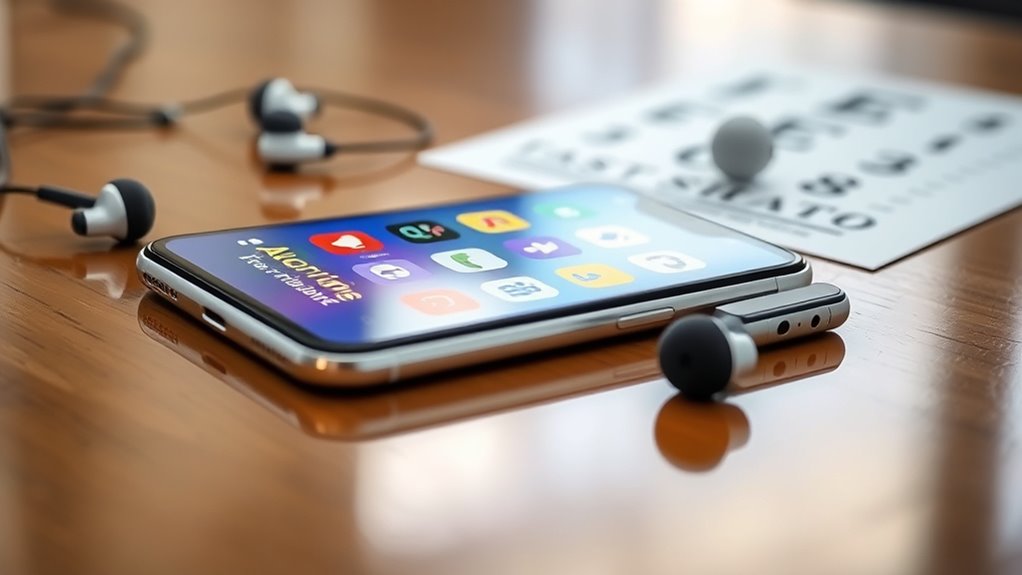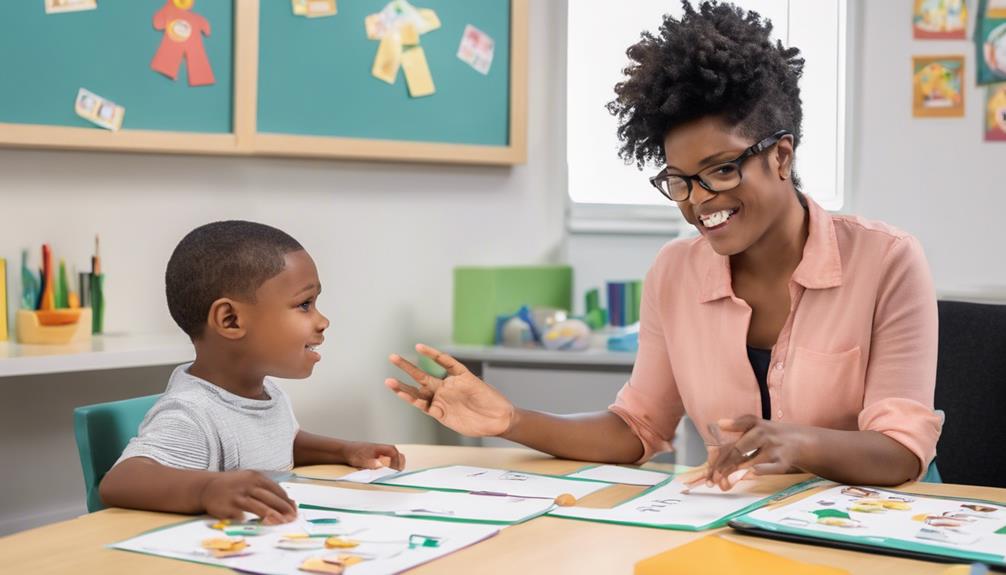Auditory training apps can help improve your listening skills by engaging your brain in exercises that strengthen neural pathways, leading to better sound recognition, speech understanding, and sound localization. While many users see improvements, research shows mixed results, and effectiveness depends on the app’s features, your motivation, and consistent practice. If you keep exploring, you’ll discover how to choose the right tools and maximize your progress.
Key Takeaways
- Neural plasticity and targeted exercises in apps can enhance sound recognition and auditory processing skills.
- Evidence on effectiveness is mixed due to small sample sizes and methodological limitations.
- Features like adaptive difficulty and progress tracking support motivation and skill development.
- Consistent practice and real-world application are crucial for transferring gains to everyday listening.
- Combining apps with professional guidance may improve overall listening skills more effectively.
The Science Behind Auditory Processing and Training
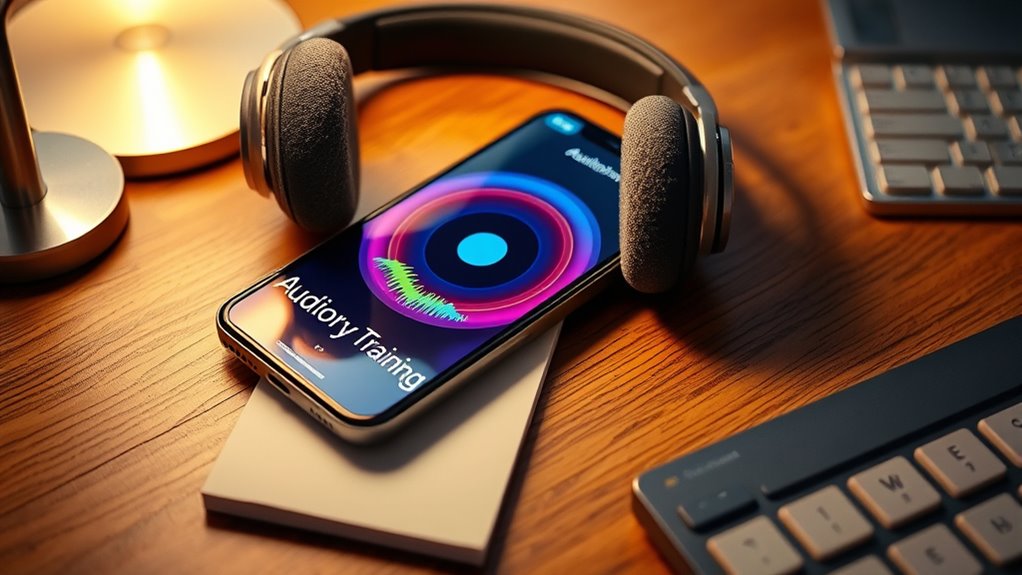
Understanding how your brain processes sound is essential to grasping how auditory training works. Neuroplasticity research shows that your brain can change its structure and functions in response to auditory exercises. This ability, known as auditory cortex adaptation, allows your brain to reorganize itself, strengthening neural pathways involved in sound recognition and interpretation. When you engage in targeted listening activities, your brain adapts by forming new connections and optimizing existing ones. This neural flexibility is what makes auditory training effective, even for adults. The more you practice, the more your brain rewires itself to better process sounds, speech, and complex auditory information. Recognizing this capacity for change underscores the scientific foundation behind auditory training apps and their potential to improve listening skills. Additionally, neural pathway strengthening is a key aspect of how consistent practice enhances auditory processing.
How Do Listening Skills Develop and Improve?

Listening skills develop through consistent practice and targeted training that challenge your brain to process sounds more efficiently. As you engage in activities like sound localization and understanding speech in noise, your auditory system adapts and strengthens. This improvement occurs by honing your ability to identify where sounds come from and to focus on specific conversations amid background noise. To support this development, focus on:
- Enhancing your sound localization skills
- Practicing listening in noisy environments
- Differentiating similar sounds
- Strengthening auditory attention and focus
Regularly challenging yourself with these exercises helps your brain adapt, making it easier to interpret complex auditory signals. Over time, you’ll notice better clarity in speech, improved ability to locate sounds, and increased resilience against auditory distractions. Incorporating Water Parks into summer outings can also provide rich auditory environments that help in practicing sound differentiation and localization skills in real-world settings.
What Do Studies Say About the Effectiveness of Training Apps?

Research shows that training apps can lead to noticeable listening improvements, but the evidence isn’t consistent across all studies. You should recognize that current research has limitations, such as small sample sizes and varying methods. Consequently, while apps show promise, more rigorous research is needed to confirm their true effectiveness. Additionally, incorporating diverse designs and materials in training tools may enhance engagement and outcomes.
Evidence of Listening Gains
How effective are training apps at improving auditory skills? Evidence from recent studies shows mixed results, often fueled by neuroplasticity myths and auditory training myths. While some research reports listening gains after app-based training, these improvements aren’t always consistent or long-lasting. Key findings include:
- Gains often depend on initial skill level and motivation
- Some studies show transfer to real-world listening, others don’t
- Neural changes are sometimes observed, but not always correlating with performance
- Variability in training protocols makes comparisons difficult
- The role of home-based training in fostering lasting auditory improvements remains uncertain.
These findings suggest that while training apps can help, they aren’t magic solutions. You should approach them with realistic expectations and be aware that neuroplasticity myths can overstate their potential. The evidence points to modest, context-dependent listening improvements rather than guaranteed, broad listening skill enhancements.
Limitations of Current Research
Despite the growing popularity of auditory training apps, current studies face significant limitations that hinder definitive conclusions about their effectiveness. Methodological challenges, such as inconsistent protocols and lack of control groups, make it difficult to compare results across studies. Additionally, many studies have small sample size limitations, reducing the statistical power needed to detect meaningful improvements. These issues lead to variability in findings and reduce confidence in the reported outcomes. Without standardized procedures or larger, more diverse samples, it’s hard to determine whether observed gains are due to the training apps themselves or other factors like placebo effects or natural development. Addressing these limitations is essential for advancing research and providing clearer guidance on the true benefits of auditory training apps.
Key Features to Look for in an Auditory Training Tool

When choosing an auditory training app, it’s important to look for features that match your needs. Make sure it offers adjustable difficulty levels, a variety of interactive exercises, and tools to monitor your progress. These features help guarantee the training stays effective and keeps you motivated. Additionally, selecting an app that incorporates evidence-based methods, such as effective training techniques, can significantly enhance your listening skills development.
Customizable Difficulty Levels
Having customizable difficulty levels in an auditory training app allows you to tailor exercises to your current skill level, ensuring you stay challenged without feeling overwhelmed. Features like adaptive difficulty adjust challenges based on your progress, providing personalized challenges that match your evolving listening skills. This personalized care approach ensures that your training remains relevant and effective, much like tailored services that address individual needs. This flexibility helps you build confidence while preventing frustration. Look for apps that offer:
- Incremental difficulty adjustments to match your growth
- Real-time difficulty scaling with your performance
- Options to focus on specific listening challenges
- Clear feedback to track your progress
These features ensure your training remains relevant and engaging, fostering continuous improvement. By selecting an app with customizable difficulty levels, you set yourself up for a more effective and motivating listening skill journey.
Interactive Exercise Variety
A variety of interactive exercises keeps your auditory training engaging and effective. Look for apps that incorporate game-based learning, which makes practice enjoyable and motivating. These games challenge your listening skills through diverse tasks, preventing boredom and encouraging consistent use. Equally important is multisensory integration, where visual cues, touch, and sound work together to reinforce learning. This approach enhances comprehension and retention by engaging multiple senses simultaneously. An app with varied exercises—such as identifying sounds, following spoken instructions, or distinguishing speech in noisy environments—keeps training dynamic. By offering diverse, multisensory activities, the app can better adapt to your needs and promote steady progress. The right variety ensures your training remains stimulating and helps you develop robust listening skills. Additionally, incorporating educational content related to auditory processes can deepen your understanding and improve your overall listening abilities.
Progress Tracking Features
Effective progress tracking features are essential in an auditory training app because they help you monitor your improvement and stay motivated. Good feedback mechanisms provide clear insights into your strengths and areas needing improvement. Look for features that offer detailed performance summaries, such as scores, accuracy percentages, and trend graphs. These tools boost user engagement by showing tangible progress, encouraging you to keep practicing. Consider apps that:
- Provide real-time feedback after each exercise
- Track your performance over time with visual charts
- Set personalized goals based on your progress
- Offer rewards or badges to celebrate milestones
Such features ensure you stay focused and motivated, making your training more effective. When an app actively monitors your development, it helps you understand your listening skills better and maintains your commitment to improvement. Additionally, adaptive difficulty settings can customize challenges to match your skill level, supporting continuous growth and confidence.
Limitations and Challenges of Mobile Auditory Training
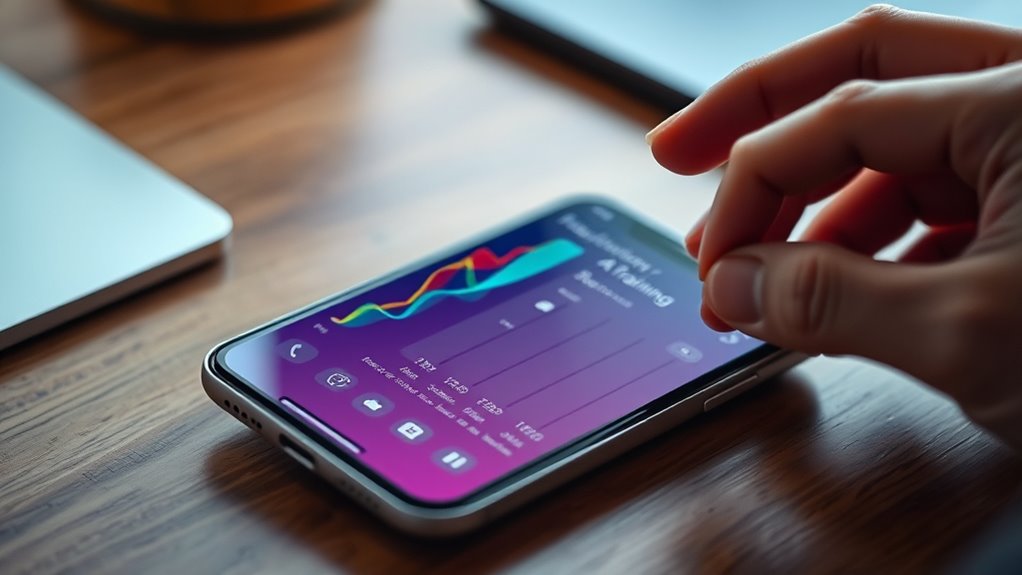
Despite the growing popularity of mobile auditory training apps, they face several limitations and challenges that can hinder their effectiveness. Technological barriers, such as outdated devices or poor internet connectivity, can prevent you from accessing or fully benefiting from these programs. Additionally, maintaining user engagement remains a significant hurdle; many users lose interest or motivation over time, limiting progress. Some apps lack personalized feedback, making it harder to track improvement or keep you challenged. Furthermore, the absence of real-time interaction with professionals can reduce accountability and customization. These challenges highlight that, while mobile apps offer convenience, their success depends on overcoming technological issues and ensuring sustained motivation to improve listening skills effectively. Regular updates and user motivation strategies are essential for maximizing their potential benefits.
Making the Most of Auditory Exercises for Better Listening
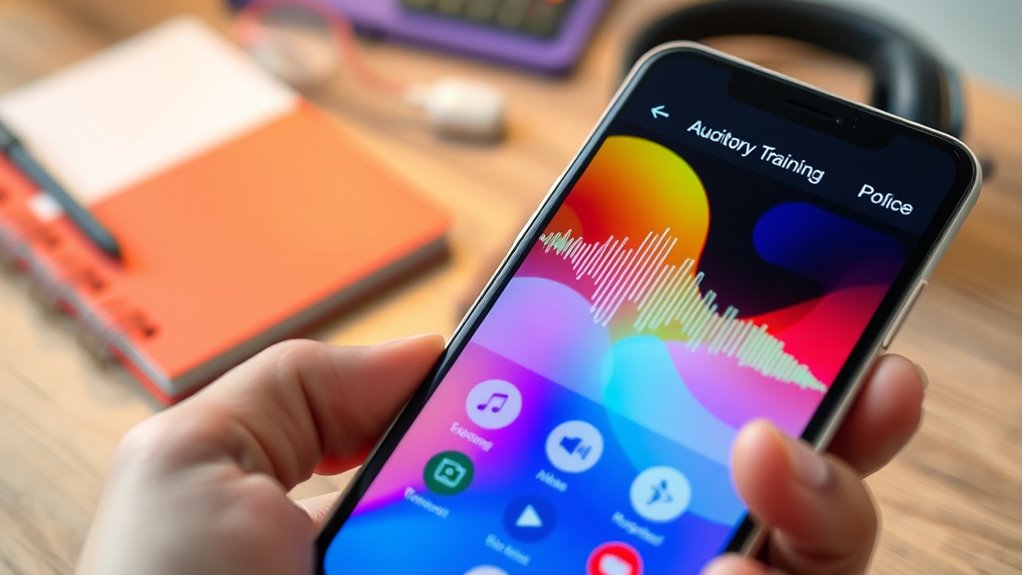
To get the most out of auditory exercises, it’s important to approach them intentionally and consistently. Minimize auditory distractions and environmental noise, which can interfere with your focus and progress. Find a quiet space where you can concentrate without interruptions. Additionally, consider these strategies:
- Schedule daily practice sessions to build habits
- Gradually increase the complexity of exercises
- Use headphones to block out external noise
- Track your progress to stay motivated
Frequently Asked Questions
Are Auditory Training Apps Suitable for All Age Groups?
You might wonder if auditory training apps suit all age groups. While they can be beneficial across ages, their age appropriateness varies, especially for young children or seniors. Tech accessibility is vital—some apps are user-friendly, but others may be too complex for certain age groups. Ultimately, choosing an app that matches your comfort with technology and developmental needs guarantees better engagement and potential listening skill improvement.
Can Auditory Training Replace Traditional Hearing Therapies?
You might wonder if auditory training can replace traditional hearing therapies. While digital hearing aids and speech recognition technology are advanced, they often work best alongside personalized therapy. Auditory training apps can supplement traditional methods by improving listening skills, but they shouldn’t fully replace professional guidance. Combining both approaches helps you achieve better hearing outcomes, ensuring you get tailored support for your unique needs.
How Personalized Are the Training Programs in These Apps?
Think of auditory training apps like a tailor-made suit—designed to fit you perfectly. The personalization level varies, but many apps offer customization options that adapt exercises to your specific needs. Some use initial assessments to tailor programs, while others let you adjust difficulty levels manually. While not all apps provide deep personalization, those that do help you focus on your unique listening challenges, making your training more effective.
Do These Apps Work for Individuals With Specific Hearing Impairments?
If you have specific hearing impairments, these apps can help, especially if they’re hearing aid compatible. They often include cognitive training exercises that boost your listening skills. However, effectiveness varies depending on your condition. For some, these apps provide meaningful improvement, but others might need additional therapy. Always consult with a hearing specialist to guarantee the app complements your hearing aids and addresses your unique needs.
What Is the Recommended Duration to See Noticeable Improvements?
You’ll likely see noticeable improvements with consistent training over several weeks. Training consistency and your commitment are key; many users start noticing progress within 4 to 8 weeks of daily practice. Keep up with your exercises regularly, and don’t get discouraged if progress feels slow at first. Staying dedicated helps your brain adapt and improve your listening skills more effectively, making your efforts worthwhile over time.
Conclusion
While auditory training apps offer convenient ways to boost listening skills, they aren’t magic solutions. You might enjoy their flexibility, but real progress depends on consistent effort and real-world practice. Don’t mistake quick fixes for lasting improvement—tech tools complement, not replace, active listening in daily life. Remember, the true test isn’t just in the app’s promises, but in how you apply those skills beyond the screen.

